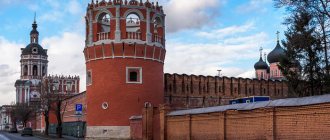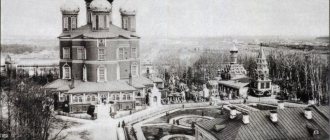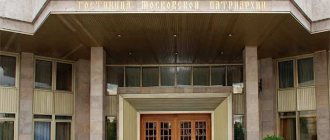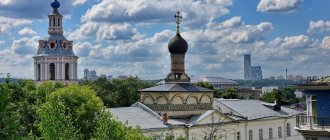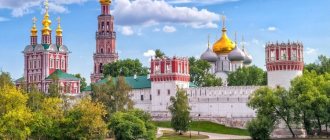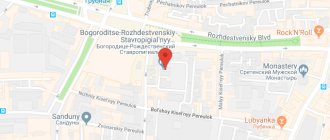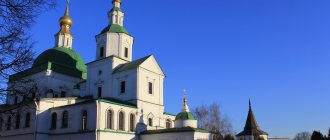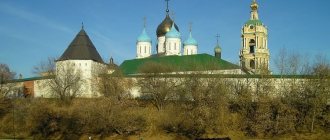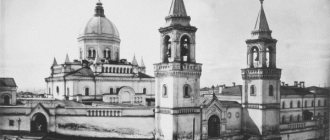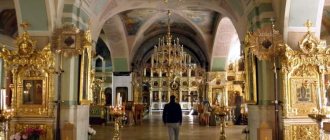| Temple of the Don Icon of the Mother of God in Mytishchi |
Mytishchi Church in honor of the Don Icon of the Mother of God in Perlovka,
Mytishchi Deanery of the Moscow Diocese
- Throne: Don Icon of the Mother of God
- Address: Russia, 141014, Moscow region, Mytishchi, st. Selezneva, 32 (Perlovskaya railway station)
- Tel.
- Official site:
- On the map: Yandex.Map, Google map
The wooden church in honor of the Don Icon of the Mother of God was built in 1896 according to the design of the architect Pyotr Pavlovich Zykov.
Architectural features of the pre-revolutionary temple
It was a small one-domed tented church in the Russian style, “an octagon on a quadrangle” - the cubic volume of the main temple space was crowned with a small octagonal frame with a tent and an onion dome, covered in the old-fashioned way with a wooden ploughshare. Belfry with bells by P.N. Finlandsky was built away from the temple.
On the plan, the Perlovskaya church was a square with a side of 7 fathoms 1 arshin (approximately 16x16 meters) with a protruding faceted apse from the east. The main space of the temple was also square in plan (approximately 8.5 x 8.5 meters), above which rose a powerful octagonal tent, the height (up to the head) approximately equal to the height of the walls of the quadrangle. The original feature of the Perlovskaya church were triangular kokoshniks with small windows, which created a second light in the interior (in addition to the light from the quadrangle windows) and gave its silhouette elegance and individuality. This motif of kokoshniks, different in shape and size, was the leading motif in the decorative decoration of the Perlovsky temple.
A tier of small kokoshniks was also located at the base of the neck of the head of the temple. The central window openings of the quadrangle were marked with traditionally shaped kokoshniks, topped with crosses, and above the entrances (west, south and north) to the temple gallery, figured three-bladed kokoshnik-cases were arranged to place icons. The church was decorated with figured platbands over the quadrangle windows and various square and rectangular panels, traditional for wooden church building of the second half of the 19th century.
Closing and destruction of the church
After the revolution, the atheists began to fight the Church. The campaign was conducted to “close the church, ... the priest and deacon of the Perlovskaya church, the chairman of the executive body Afanasyev and other malicious churchmen to be evicted from the Mytishchi district, ... prayers for all religious associations to close.”
An anti-religious demonstration was held and a collection of signatures was organized for the closure of the temple. They said that the same person signed ten times. Even small children from 7 years old were included in the collection of signatures.
The Moscow Regional Executive Committee closed the temple in Perlovka three times: on April 21, 1931, September 22, 1935, and August 23, 1940. From the end of 1940 to 1970, by decision of the Mytishchi executive committee, the church building was rebuilt and occupied by tenants.
In 1981, the Donskaya Church was completely destroyed, only the brick foundation remained.
Revival of the parish
On October 11, 1994, an Orthodox parish in honor of the Don Icon of the Mother of God was registered in Perlovka.
Since December 4, 1995, services have been held on the veranda of a private house on 1st Yaroslavsky Lane, building No. 5.
In March 1997, at the request of the parish, the administration of the Mytishchi district allocated to the Perlovskaya Orthodox community part of the house No. 32 on Selezneva Street: by this time the number of parishioners had increased, and it became difficult to lead parish life on the small veranda of a private house. On May 18, 1997, the religious service was moved to the market square, to house number 32 on Selezneva Street. The altar was set up in a military field tent, and parishioners prayed in the open air. The second floor of the allocated part of house No. 32 was occupied by residents, and the temple community, with the consent of the district administration, began to improve the first floor, which was in an extremely neglected state.
In parallel with the conduct of liturgical activities in the new building, the parish was in correspondence with the city authorities about the return of the land plot on which the Don Church was built 100 years ago. The Land Commission, by protocol No. 15 of June 23, 1998, made a positive decision to allocate a former plot of 0.4 hectares for the reconstruction of the temple. Initially, a plot of land for the reconstruction of the destroyed Donskaya Church was allocated along Ulyanovskaya Street, completely different from where the church was originally located. With the personal participation of the then head of the Mytishchi district, Anatoly Konstantinovich Astrakhov, the land plot was re-registered, and the community was allocated a plot on Selezneva Street, on which the remains of the foundation of the former church were still preserved.
Part of house No. 32, the community of the Don Church asked the administration to organize an Aesthetic and Spiritual Center for the education of children and adolescents in the traditions of Orthodoxy.
On May 30, 1999, the consecration of the foundation stone took place on the site where the Don Church previously stood. The night before, at about half past three, the building in which the church was located was set on fire by unknown attackers...
Construction of the first stage of the building for the Orthodox cultural and educational center with a house church in the name of the Holy Life-Giving Trinity has begun.
Since March 2000, conversations have also begun with children of primary school age. Groups of choral singing, sewing, embroidery, beadwork, and icon painting were formed. Since the fall of 2000, there has been a Sunday school for children and adults.
On August 1, 2003, a chapel in honor of St. Seraphim of Sarov at the Don Church was consecrated. Under Father Anatoly, spiritual conversations were held there. In the warm season, akathists of gratitude to the Lord Jesus Christ were read. Three times a year the early Divine Liturgy was served here: August 1 - the day of the discovery of the relics and glorification of St. Seraphim of Sarov, January 15 - the day of repose and the second discovery of his relics and September 1 - the patronal feast of the Don Icon of the Mother of God. Since Christmas 2012, liturgies in the church-chapel of St. Seraphim of Sarov have been performed regularly - every Sunday at 9 am.
On June 6, 2004, the consecration of the Trinity Church took place. The celebrations were led by Archbishop Grigory (Chirkov) of Mozhaisk.
Sunday school classes resumed in the church and the lower church was transformed. A new carved iconostasis appeared. In 2005, artists V.I. Sherdin, A.V. Ilina, I.V. Lukina, E.V. Kuprina, V. Kuteko, the lower church was decorated and painted.
Since Christmas 2012, in the church of St. Seraphim of Sarov, regular Sunday services began, and the attic floor was specially converted for a youth club.
Thanks to the help of donors, a block container for collecting clothes for those in need and prisoners was purchased, its technical equipment was installed, and a roof was made. Two more block containers are intended to temporarily serve as classrooms. One of them was also purchased, and the other was built on site by workers from purchased building materials. A common roof was built over the block containers. “Building No. 2” and “Building No. 3” are listed in the schedule of theological courses and clubs operating at the Spiritual Center.
Founding of the monastery
In 1591, the army of the Crimean ruler, the powerful Kazy-Girey, approached Moscow itself. The city was ready for defense, but its residents were preparing for the worst. By order of the Russian sovereign Fyodor Ioannovich, a crowded religious procession was held around the capital. And the tsar sent the defenders of the city the famous icon of Our Lady of the Don, which, according to legend, was with Dmitry Donskoy during the famous Battle of Kulikovo.
Then there were several local skirmishes between Russian warriors and Tatars, however, the decisive battle never took place. The Tatar troops camped for several days and, unexpectedly for everyone, turned back.
The amazing rescue of Moscow caused universal joy and rejoicing. In honor of the great miracle, the Russian sovereign ordered the founding of a new monastery. And the place chosen for it was the territory of “Gulyai-Pole”, where the mobile army that met the Tatars was located.
The Battle of Kulikovo took place on the church holiday of the Praise of the Mother of God, so the new monastery was first dedicated to the Mother of God.
View of the towers and walls of the monastery from the street. Donskaya
The emergence of the ancient monastery
The Donskoy Monastery was founded by Tsar Fyodor Ioannovich in honor of the Don Icon of the Mother of God in gratitude for the deliverance of Moscow from the invasion of the Crimean Khan Kazygirey in 1591.
With this icon, St. Sergius of Radonezh blessed Grand Duke Dmitry Ivanovich and his soldiers during the Battle of Kulikovo, which took place near the Don. The icon was brought by the Don Cossacks, who came to the aid of the Grand Duke in the battle with the Tatars.
The shrine was with the Russian soldiers on the battlefield, and after the brilliant victory of the Russian warriors it was named Donskoy, like Prince Dmitry Ivanovich, to whom the Cossacks presented the icon as a gift.
When Kazygirey found himself on the approaches to the Mother See in 1591, Tsar Fyodor Ioannovich ordered a religious procession around Moscow with the Don Icon of the Mother of God and then placed it among the military ranks. The Emperor spent a sleepless night in prayer in front of the icon.
The next day, at the height of the battle, the Tatars fled in panic, leaving the dead, the wounded, and all their belongings, or, as they called it, “the convoy,” on the field. In gratitude for the heard prayer and miraculous help, in 1591 Fyodor Ioannovich founded the Donskoy Monastery, where the miraculous icon was placed. The day of celebration of the shrine is August 19 (September 1).
the Small Don Cathedral was built in 1593 . 100 years later, a second, so-called Great Don Cathedral appeared nearby. The Donskoy Monastery is the only monastery where there are two churches of the same name.
History of the monastery in the XV-XIX centuries
A cathedral was immediately built in the monastery, dedicated to the icon that saved Moscow. The new stone church was called the “refectory”, and after the construction of the Great Monastery Cathedral it began to be called “Small”. Researchers suggest that the architect of the first monastery cathedral could have been the famous architect Fyodor Kon, thanks to whom the walls of the White City grew.
The monastery stood to the south of the capital, covering the strategically important Kaluga road. Together with other monasteries, it was part of a fortified ring created to defend the city from enemies.
During the Time of Troubles, the monastery was plundered by Polish troops led by Hetman Chodkiewicz. After this, the devastated monastery was not restored for several years and was subordinated to the Moscow Andronikov Monastery.
The revival of the Donskoy Monastery took place thanks to the efforts of Tsars Mikhail Fedorovich and Alexei Mikhailovich. During their reign, the monastery became popular among pilgrims, and religious processions were held through the “pious place,” in which ordinary Muscovites, noble boyars and Russian sovereigns took part.
The bell tower of the monastery with the church in the name of Saints Zechariah and Elizabeth
In 1705, the monastery welcomed a new abbot. Peter I entrusted the leadership of the monastery to Archimandrite Lawrence (Gabashvishi). The Moscow monastery began to play the role of a cultural center between Russia and Georgia, and the descendants of the Georgian royal and famous princely families were buried in the monastery.
In the 70s of the 18th century, there was a plague epidemic in Moscow, after which it was decided to no longer bury citizens in cemeteries within the city. From that time on, the monastery necropolis began to grow, and representatives of many famous noble families of Russia - the Trubetskoys, Dolgorukovs, Vyazemskys, Golitsyns and Naryshkins - found refuge there.
Like other monasteries in Moscow, the Don Monastery was badly damaged during the invasion of Napoleon's troops. She really was lucky. Despite the severe fires, all the monastery buildings remained intact and were quickly restored.
Gradually the monastery became one of the significant spiritual and educational centers. In 1834, a theological school was opened here, the graduates of which could continue their education within the walls of the seminary. It is noteworthy that children from poor families received education for free.
Great Cathedral of Our Lady of the Don
Monastery in the 20th century
The Orthodox monastery is famous for the fact that Patriarch Tikhon spent the last years of his life within its walls. After the revolutionary events of 1917, he publicly condemned the atrocities that were happening and was persecuted for this. The Patriarch was isolated from his flock, and he lived in a monastery.
In the spring of 1925, the disgraced church hierarch was buried in the Small Monastery Cathedral. The following year the monastery was closed. An anti-religious museum was created on its territory. Then a boarding school was opened here, and after that a factory and a dairy farm.
Since 1935, an architecture museum has opened on the monastery territory. Fragments of ancient buildings to be destroyed began to be brought for him from different parts of the city. Thus, high reliefs of the destroyed Cathedral of Christ the Savior, ancient tombstones from dug up cemeteries and carved frames taken from the Sukharevskaya Tower came to the former monastery.
Small Cathedral of Our Lady of the Don
A few years after the Great Patriotic War, the Small Cathedral was returned to the church, but the monastery itself was not restored. The question of reviving monastic life was raised in 1982, but several years of discussions did not lead to any result. Only in 1990 did the monastery buildings become the property of the church. After this, large-scale restoration work began here.
Walk through the Donskoi Monastery and Donskoi Cemetery
Donskoy Monastery. Grave of Prokofy Akinfovich Demidov. The graves of Vasily Perov, Nikolai Zhukovsky and Alexander Solzhenitsyn. High reliefs from the Cathedral of Christ the Savior. Anton Ivanovich Denikin, General Kappel and philosopher Ilyin. Cenotaph of Yasyuninsky. Chaadaev's grave. The graves of Alexander Pushkin's grandmother and uncle. Don Cemetery. Faina Ranevskaya and the dog Boy. Pilots' graves. Common grave No. 1 (1930-1942). The grave of Maria Hartung, Pushkin's eldest daughter. Common grave No. 3, aka “Mommy”. Common grave No. 2 (1943-1944). The grave of Sergei Muromtsev, chairman of the first State Duma.
The day before, my wife and sister-in-law went to a performance telling the story of the last year of Faina Ranevskaya’s life, and they had the idea of visiting her grave at the Donskoye Cemetery. I volunteered to accompany them, since the weather was wonderful. We met at the Shabolovskaya metro station and then set off on foot. It takes about ten minutes to walk to the Donskoy Monastery; the Donskoy Cemetery adjoins it on the right (south).
The Donskoy Monastery is in a state of permanent restoration.
Great Cathedral
Small Cathedral
Western passage gate with gate church and bell tower
The sisters immediately went to the monastery, deciding that the cemetery could wait.
I was decidedly not ready to give a tour of the monastery, but I remembered that about five years ago I found the grave of Prokofy Demidov on the territory of the monastery and took the young ladies to it:
Grave of Prokofy Demidov
-There was such a famous dynasty of industrialists - the Demidovs. Unlike the Stroganovs, who financed Ermak’s expedition to Siberia, the Demidovs became famous (and arose) much later. The ancestor of the family, Nikita Demidovich Antufiev, made such nice (and cheap) guns that Peter I made him a supplier of weapons for the army during the Northern War. And at the same time he gave me a new last name.
-His son, Akinfiy Nikitovich Demidov, together with his brothers and descendants, received hereditary nobility in 1726. Nobility was granted to the Demidov family by Catherine I, the wife (by that time already a widow) of Peter I. Being herself without a family, without a tribe, the former Catherine Skavronskaya knew how to evaluate nuggets. Just like herself. The city of Yekaterinburg was named in honor of Catherine I. If anyone doesn't know. At one time Sverdlovsk was called the same as Perm - Molotov.
-Prokofiy Akinfovich Demidov (1710-1786), grandson of the founder of the dynasty, was famous for his eccentricities. In 1778 (for example), Prokofy organized a national holiday in St. Petersburg, so generous that half a thousand people “glued their flippers together” and drunk themselves to death. Once he bought all the hemp in St. Petersburg so that the British (who, according to Prokofy, had fleeced him during his stay in London) would not get it. Catherine the Great considered Prokofy a daring talker. Yes, that’s how it was, in essence. But what, exactly, could be taken from a person who, until the age of 16, was listed as a state blacksmith, and after that as a hereditary nobleman? The roof moves slowly, quietly rustling like slate... And it’s not surprising.
-Prokofy had an enormous fortune and a kind heart (which did not prevent him from being a typical tyrant - there were no restrictions on anything at all), but if he owed his heart (most likely) to the karma accumulated by the family, then his fortune was due to his brother Gregory. The fact is that their father, Akinfiy, left most of the inheritance to his son from his second marriage, Nikita. Gregory obtained from Empress Elizabeth Petrovna the division of his father's property equally among all the brothers. Prokofy, who (in principle) did not serve anywhere, received the rank of full state councilor for charity: with the 1 million 107 thousand rubles he donated (in particular) the Moscow Orphanage was founded.
-According to the “Table of Ranks,” the civilian rank of active privy councilor corresponded to the rank of army major general.
Portrait of P.A. Demidov brushes D.G. Levitsky, 1773, Tretyakov Gallery
-Since 1750, Prokofy lived permanently in Moscow. In 1754, he (from different owners) bought the lands that now make up the northern part of the Neskuchny Garden, where he built a Baroque palace and greenhouses, and also laid out a garden. He used seed and vegetative material from the first private botanical garden in Russia near Solikamsk, which belonged to his brother Gregory.
-Seven hundred of Prokofy’s serfs worked for two years to level the hill so that the garden would take the shape of an amphitheater. Its five terraces of varying widths and heights, 200 meters long, descended to the Moscow River. Several stone greenhouses with a total length of more than half a kilometer were built for growing heat-loving plants. A pond has been dug and lined with trees.
-P.A. Demidov lived an open house and welcomed guests. But he knew the value of the guests. And if one of the guests of the estate tried to rip off some rare plant from his (Prokofy’s) unique garden, then some of the copies of antique statues (naked watchmen, smeared with chalk) on pedestals “came to life,” shaking their fingers at the sneers.
-It was from then on that the name “Neskuchny” stuck to the garden.
-They buried P.A. Demidov at the cemetery of the Donskoy Monastery. The grave has been preserved.
-I found it according to the description given in the book by Alexei Timofeevich Saladin “Essays on the History of Moscow Cemeteries.”
-Here is his description of the grave of Prokofy Akinfovich Demidov:
“At the very altar wall of the new cathedral stands out a huge gray monument to Prokofy Akinfovich Demidov* (1710-1786), known for his charity and eccentricity... Of his eccentricities, all of Moscow was familiar with his departure in a train. The zug consisted of six horses - the two front and two rear were small, and the middle pair was disproportionate in size. The postilion of the big horse was a dwarf, and the postilion of the little horse was a giant, and his legs dragged along the ground. The footmen were dressed in comic livery: one half was embroidered with gold braid, and the other was a simple homespun; a patent leather shoe was worn on one foot, and a bast shoe on the other.”
*The monument is partially destroyed, deprived of four plaques with inscriptions, an urn and decorations. One of the four plaques has been restored and contains an excerpt from the epitaph. (note by S.Yu. Shokarev).
-In principle, on the plan of the necropolis of the Donskoy Monastery, the grave of P.A. Demidova is marked (section 71-X). That is, it is located near the left side of the Great Cathedral of the Don Icon of the Mother of God.
-The problem is that there are several tombstones from the 18th century in that corner, and all of them were erected to someone unknown: practically no inscriptions have survived. I have no doubt that an inventory of monuments exists, but it’s not on the Donskoy Monastery website.
-On the leftmost (and highest) monument, remains of inscriptions were still found. It followed from them that this monument was erected on Demidov’s grave.
Grave of P.A. Demidova, June 26, 2016
-The epitaph on the best preserved (white marble) tablet read something like this:
“During this temporary life, in all fairness, he acquired the venerable immortal titles of the most cordial son of the Fatherland and friend of Humanity, sacrificing for the benefit of both most of his own fortune, for which, having previously had no military or civil rank, he was suddenly elevated by the hands of the Monarchs was awarded the degree of actual state councilor. It remains for posterity to judge whether he was worthy of this excellent, famous Honor.”
-A couple of other signs have disappeared, but in one niche you can still read (albeit with difficulty) the following text:
“This tomb was built by my wife Tatyana Vasilievna Demidova as a sign of respect for the deceased and gratitude. 1789, July... day."
-Definitely the grave of Prokofy Akinfievich Demidov, because:
“At the age of 74, he got married to his long-time partner Tatyana Vasilyevna Semyonova... who was 36 years younger than him. He described this event to his son-in-law this way: “Yesterday, June 30, the priest lured me into the church and made your mother-in-law excellent, only brother Nikita was there, otherwise no one knew.”
Source: Wikipedia
-Nearby is the grave of the artist Vasily Perov, who died of consumption at the age of 49. The artist was buried in the cemetery of the Danilov Monastery, but after the liquidation of the necropolis there, the ashes were transferred here and a new monument was erected.
-Near it is a monument to the grave of the father of Russian aviation, Nikolai Zhukovsky.
-The grave of Alexander Solzhenitsyn.
We looked at the high reliefs of the Cathedral of Christ the Savior, the original one. I didn’t plan to photograph them on carpets - there are plenty of photographs of the Donskoy Monastery in my home collection, taken over the years.
-Why weren’t they used during the restoration of the temple? - asked the sister-in-law.
“Zurab Tsereteli said then that bronze copies of high reliefs are more durable,” I answered. “It was most likely more profitable to make them.” It's time to restore these old high reliefs. Under Soviet rule, the Donskoy Monastery was turned into an architecture museum and fragments of destroyed monuments were brought here, including the dismantled Arc de Triomphe. It was later reassembled on Kutuzovsky Prospekt, but the extra parts remained - I saw them myself in the monastery: it’s just that now part of the monastery territory is inaccessible.
“Come on, I’ll show you the grave of Anton Ivanovich Denikin,” I suggested.
“He seems to have fought for the whites,” his wife recalled.
“Exactly right,” I confirmed. “Commander-in-Chief of the Armed Forces of the South of Russia.” He died in the USA, his ashes and his wife were transferred here in 2005.
-To the right of the Denikins’ grave is the grave of the General Staff of Lieutenant General Vladimir Oskarovich Kappel. You remember him from the film “Admiral” - he was eager to help Kolchak. The ashes were transferred from Harbin.
Kappel's grave
-To the right of Kappel’s grave is the grave of the philosopher and writer Ivan Ilyin and his wife. Ilyin, on the personal instructions of Lenin, was expelled from Russia on the Philosophical Steamship in 1922. Together with other 160 decent people. The ashes were transferred from Switzerland.
-But this monument near the wall has a strange history. Konstantin Arsenievich Yasyuninsky was a prominent merchant and industrialist, a member of the State Council of the Russian Empire.
Cenotaph of Yasyuninsky
-Died suddenly at the age of 43, was buried either in Spaso-Andronikov, or in the Novodevichy Convent (or the cemetery attached to it). In Soviet times, the tombstone from his grave (without reburial of the ashes) was moved to the necropolis of the Donskoy Monastery.
Then we came across a diagram of the necropolis and decided to find the graves of Chaadaev, as well as the grandmother and uncle of Alexander Sergeevich Pushkin.
Chaadaev's grave was found quickly, on the right side of the Small Cathedral.
The Pushkin graves were found on the right side of the Great Cathedral.
Grave of Vasily Lvovich Pushkin
Behind the monument to Uncle Pushkin one could see the same monument at the grave of Anna Lvovna Pushkina.
Anna Lvovna Pushkina's grave
And we decided that this was the grave of Pushkin’s grandmother. But at home, having looked at the photo, I was embarrassed: Anna Lvovna was listed on the monument as the daughter of a lieutenant colonel and a maiden. There was a third monument on the site, but repairs made it difficult to get to it. My own home archive came to the rescue (as always): in it I found a photograph that I had taken back in 2014. So, Olga Vasilyevna Pushkina (nee Chicherina), wife of artillery Lieutenant Colonel Lev Aleksandrovich Pushkin, grandmother of the poet.
At this point we finished with the monastery, went out the gates and entered the gates of the Donskoye Cemetery.
Then I felt completely at ease, because the day before I had read everything that I had written about the cemetery several years ago, and now I was telling my sisters:
-The cemetery was formed at the beginning of the last century (due to the fact that there were no burial places left in the Donskoy Monastery) and the gopota were not buried here, but more and more decent people: the artist Valentin Serov, the composer Sergei Taneyev, the poet Vladimir Mayakovsky. All three burials were later moved to the Novodevichy cemetery. Many senior officers who died in the First World War are buried here.
-Let's start from the right side: except for Faina Ranevskaya, none of the famous people are buried there. Her grave is somewhere at the end of the cemetery, not far from the brick fence. There is a white bench nearby.
Ranevskaya's grave, photo from 2016
And we found her.
Ranevskaya's grave, photo 2022
Only now a tiny figure of a sad dog appeared on the gravestone. Ranevskaya had a dog, which she picked up on the street and named Boy. They couldn't live without each other.
We walked a little forward, to the southeastern part of the cemetery, and came across a whole alley of graves of pilots, often buried by entire crews.
“You have to have such a surname,” the sister-in-law was surprised. “Gay Vladimir Georgievich.” No luck with the last name.
“He was unlucky to die at the age of 44,” I objected. “And in 1966, when this happened, they didn’t even know the words.”
-In 1904-1914, construction of the Orthodox Church of St. Seraphim of Sarov and the Holy Blessed Princess Anna Kashin was carried out on the territory of the cemetery. The unfinished church (although consecrated in 1914) was adapted by the Bolsheviks (1927) into a crematorium and columbarium. Bodies were brought here by truck from Lubyanka and Lefortovo. Grave No. 1 contains the ashes of 4,259 people. Among them: Blucher, Tukhachevsky, Yakir, Uborevich, Kosyrev, Meyerhold and Babel. There are three such graves in total in the cemetery. In the third grave (according to rumors) many executed leaders of the White movement are buried: Ataman Semenov, generals Krasnov and Shkuro. In the 1990s, the crematorium was closed and became a temple again.
-Last time I only found grave No. 1. It would be interesting to look at the other two.
“We’ll find everything,” the sisters said cheerfully.
It turned out that this is not so simple: there is no more or less detailed plan of the cemetery.
Common grave No. 1 (burial of unclaimed ashes from 1930 to 1942 inclusive) was found immediately.
But the other two had to be looked for. While they were looking, I again found a bronze Red Army soldier with a rifle. At the extinguished Eternal Flame.
The Red Army soldier still guarded the stele, which read: “To the soldiers and commanders of the UKMK Special Forces Regiment who died at a combat post on August 12, 1941.”
“The abbreviation “UKMK” stands for “Office of the Commandant of the Moscow Kremlin NKVD of the USSR,” I explained. “On that day, August 12, 1941, German aircraft bombed the Kremlin. Bombs hit the Arsenal, killing 20 people.
During the search, I again discovered the grave of Alexander Pushkin’s eldest daughter.
-Maria Alexandrovna Hartung (born 1832) in 1860, at the age of 28, married Leonid Nikolaevich Hartung (two years younger than her), I recalled. Leonid Hartung rose to the rank of major general, managed the Imperial stud farms in Moscow and Tula. In 1877, unfairly accused of embezzlement, Hartung shot himself and Maria Alexandrovna was left alone: they had no children.
-It was from Maria Alexandrovna that L.N. was copied. Thick appearance of Anna Karenina. Maria Alexandrovna died in Moscow in 1919 from hunger. Lunacharsky “knocked out” a personal pension for her, but she didn’t have time to receive it.
Again I saw an elegant white marble monument with a cross and the inscription: “Prince Petr Petrovich Isheev. Born November 12, 1862. Died. April 22, 1922 Peace be upon your ashes, unforgettable dear friend.”
“Pay attention,” I suggested. “All estates were abolished a long time ago, and the Civil War ended, and the NEP was proclaimed, but here everything is still the same: a prince, and even with the old spelling.” By the way, I never managed to find out anything about this prince.
-Monument to the artist Avvakumov by Evgeniy Vuchetich.
Finally, tired of it, they asked the cemetery worker.
“Common grave No. 3 to the right of the Eternal Flame is located in a spruce forest,” he readily explained. “We call her “mommy.” And common grave No. 2 is to the left of common grave No. 1, among the graves.
And we went to common grave No. 3, in memory of the victims of political repression of 1945-1953.
And they immediately understood why they called her “Mommy”: in the center of the clearing there was a statue of a kneeling woman.
In the end, we found common grave No. 2 (burial of unclaimed ashes from 1943-1944) and headed towards the exit.
Just next to the wall to the left (if you look from the entrance) is the grave of Sergei Andreevich Muromtsev, chairman of the first State Duma. Cadet, expelled from the nobility for his political activities. He died at the age of 60 in his sleep from a heart attack. On the tombstone (1912, architect F.O. Shekhtel) there is a bust by Paolo Trubetskoy. The monument was the last one I showed to my sisters.
Our walk took two hours.
Leaving the cemetery, we headed towards the Leninsky Prospekt metro station, buying ice cream on the way: it was a hot day.
Anatoly Novak,
May 26, 2022
What can you see in the monastery
Visitors enter the monastery through the gates of the high bell tower, which houses the temple of Zechariah and Elizabeth. At the entrance you can see several picturesque hagiographic icons on the walls.
The oldest surviving temple is the Small Cathedral. The new or Great Monastery Cathedral appeared at the end of the 17th century.
This was the time when large-scale stone construction was carried out in the monastery. At the same time, powerful walls with openwork towers were erected around the monastery.
Alexander Nevsky Church
Since the end of the 19th century, the Church of St. John the Climacus has stood here. It was erected with the money of General Tereshchenko and served as a family crypt. Another crypt of members of the Zubov family is located in the Church of Alexander Svirsky, the round building of which looks like a classical rotunda.
The picturesque Church of St. John Chrysostom became the tomb of the Pervushin merchant family. Another church, dedicated to the Tikhvin Icon of the Mother of God, completes the northern gate of the monastery.
Most of the monastery territory is reserved for the necropolis. It appeared at the end of the 17th century and by the 19th century it turned into a place where high-born merchants and the elite of the Russian nobility were buried. Close relatives of the poet A.S. Pushkin lie in the monastery cemetery.
Here are the graves of the famous Russian mechanic N. E. Zhukovsky, the historian V. O. Klyuchevsky and the landowner Saltychikha, known for her cruelty. Among other graves you can see the tombstones of Russian generals V. O. Kappel and A. I. Denikin, philosopher A. I. Ilyin, as well as writers I. S. Shmelev and A. I. Solzhenitsyn.
Church of St. Tikhon, Patriarch of All Russia
Churches of the Donskoy Monastery
The Church of the Archangel Michael was built at the expense of Princess Anna Golitsyna in 1806 on the site of the dilapidated Church of Euthymius the Great. The cubic volume is topped by a head on a wide drum. On the western side there used to be a hospital, converted into a refectory.
The church in honor of Prince Alexander Nevsky was erected in 2006 on the site of the former monastery gardens. It is crowned with a drum with a bulbous head. Nearby is the elegant Water Blessed Chapel.
The Church of St. Tikhon was founded in 1997 with the blessing of Patriarch Alexy II. The church is made of brick and covered with an 8-slope roof. The temple, crowned with an onion dome on a high drum, is decorated with kokoshniks.
The Church of St. George the Victorious was built in 2000 using the technique of severe fresco. The octagonal temple, decorated with flat pilasters, is crowned with a rounded roof and a tier of bells.
The Church of John Chrysostom and the Great Martyr Catherine was built in the Byzantine style in 1888 at the expense of the Pervushin merchant family as a family tomb. In the lower tier is the Church of the Great Martyr Catherine.
The Church of St. John Climacus was built in 1898 at the expense of the Major General as a chapel-burial vault for his family. On the western side there is a closed porch-porch. The walls are decorated with decorated patterns made of molded bricks and stucco details. The facades were restored with a new iconostasis installed in 1990.
The Church of St. Alexander Svirsky was erected in 1786 in the style of classicism in honor of the heavenly patron Count Nikolai Zubov. The facades are decorated with pilasters, the interior was restored in 1996 and the iconostasis was re-painted.
The Temple of the Righteous Zechariah and Elizabeth was built in 1730 and abolished after the destruction of the monastery by the French, restored in 1990. The temple contains paintings from the history of the monastery.
The Gate Church of the Tikhvin Icon of the Mother of God is a four-tier church, the upper level, separated by vaults with open arches, is intended for a belfry. Patriarch Tikhon prayed here during his imprisonment. The main entrance to the church is opposite the Great Cathedral on the north side of the fence. Near the porch there is a forged cast-iron lattice from the early 18th century and an iconostasis from 1782. The church was built in the 18th century with the money of Tsarina Praskovya Fedorovna, the wife of Ivan IV Romanov.
Above the gate on the western side is a three-tiered bell tower with an elegant clock. At the entrance to the monastery there is a chapel dedicated to a happy event: the rescue of the royal family during the crash of the train in which they were located.
More than 100 monks live in the fraternal buildings, made of red brick.
Shrines
The main shrine of the men's monastery is considered to be the Don Icon of the Mother of God (16th century), which was painted by the famous Russian iconographer Theophan the Greek. The image, revered by believers, is constantly in the State Tretyakov Gallery, but once a year it is brought to the walls of the monastery.
In the Great Monastery Cathedral there is a shrine where the relics of Patriarch Tikhon rest. In addition, pilgrims come to bow to the burial place of Yakov Polozov, who was a cell attendant under Patriarch Tikhon.
Monastic necropolis
Story
In Rus', fortress monasteries were often built around large cities for their defense. This is how the Novodevichy and Simonov, Andronikov and Novospassky, as well as the Danilovsky monasteries were built. In 1591–1592, Tsar Feodor Ioannovich and boyar Boris Feodorovich Godunov founded the Donskoy Monastery in Moscow in memory of the deliverance from the invasion of the Crimean Khan Kazy-Girey.
This completed the creation of a defensive semi-ring of fortresses that protected the capital from steppe raids. The first stone cathedral was built in the name of the Don Icon of the Mother of God. Now this is the Small or Old Cathedral.
During the Time of Troubles, the Donskoy Monastery was devastated by Polish troops. Stone walls and towers, reminiscent of the fence of the Novodevichy Convent, were erected in 1686. In 1698, a new majestic temple, also dedicated to the Don Icon, was consecrated - the Great Cathedral, built with the help of Princess Ekaterina Alekseevna.
In 1745, the Donskoy Monastery was classified as stauropegial, that is, subordinate directly to the patriarch. At that time it was a large feudal economy. A majestic monastery complex is being formed. In 1713–1714, the Tikhvin Gate Church was built.
By the middle of the 18th century, the construction of the bell tower over the western gate and the archimandrite's chambers was completed.
The theological seminary building and outbuildings are being constructed. And by 1798, the Church of Alexander Svirsky was completed. Since the end of the 17th century, the Donskoy Monastery became the tomb of the Moscow nobility. In the Sretensky Church there is a tomb of the Georgian kings, in the St. Michael's Church there is a tomb of the Golitsyn princes. One of the sad events in the life of the monastery occurred in 1771 during the Plague Riot. To prevent the spread of infection, Archbishop Avmrosy ordered the miraculous icon, to which both sick and healthy parishioners had venerated, to be removed from the Barbarian Gate. For this, the crowd tore the bishop to pieces. By order of Catherine II, the instigators of the riots were hanged on Red Square.
In 1914, a temple was consecrated on the new territory of the cemetery adjacent to the monastery. Since 1922, His Holiness All-Russian Patriarch Tikhon was in custody at the monastery. In 1925, after dying in hospital, he was buried in the Small Cathedral. In 1926, the monastery was closed, but monastic life continued until the end of the 1920s. Then an anti-religious museum, a boarding school and even a farm were opened here. The Church of Seraphim of Sarov and Anna Kashinskaya at the new cemetery was converted into a crematorium.
The remains of demolished Moscow churches were brought to the territory of the Donskoy Monastery. During the Great Patriotic War, an entire tank column of 40 units of equipment was built at the expense of believers. At the entrance to the monastery there is a Dmitry Donskoy tank, a cannon and armored personnel carriers. Services in the Small Cathedral resumed in 1949. A furnace was built in the church, which is still used to this day to make myrrh (fragrant oil for anointing the human body) for the entire Russian Church. In November 1982, Brezhnev signed an order to transfer the monastery to the Moscow Patriarchate to house the Patriarch's residence there. Due to the death of the General Secretary, this decision was suspended, and then the Danilovsky Monastery was given to the Patriarchate. In 1991, the monastery was transferred to the Moscow Patriarchate. The brethren were small in number. On August 18 of the same year, the Great Cathedral was re-consecrated.
In 1992, during the renovation of the Small Cathedral after a fire, the burial place of Patriarch Tikhon was opened. His relics were placed in a shrine and later transferred to the Great Cathedral.
On September 1, the day of celebration in honor of the Don Icon of the Mother of God, the Divine Liturgy is celebrated in the Great Cathedral. According to tradition, in connection with the holiday, the miraculous Don Icon is delivered to the monastery from the Tretyakov Gallery. Since 2010, the holiday in honor of the Don Icon of the Mother of God, with the blessing of His Holiness, has become the main holiday of the Russian Cossacks.
How to get to the monastery
The monastery is located 5.5 km south of the Moscow Kremlin. The monastic territory is 1.1 km from the Shabolovskaya metro station, 1.5 km from Leninsky Prospekt and 2 km from Tulskaya. Trams No. 14 and 39 stop nearby. You need to get off at the “Peoples' Friendship University” stop. In addition, the entrance to the monastery can be reached on foot from Leninsky Prospekt - from the public transport stop “Institute named after. Kurnakov."
Attraction rating
Rating 5.00 [1 Vote]
| ← MONASTERIES OF MOSCOW | MOSCOW → |
